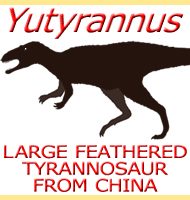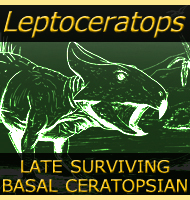


Ichthyovenator
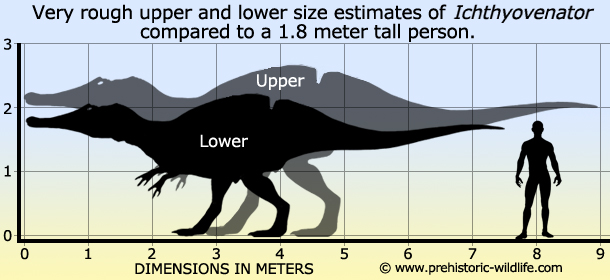
Name:
Ichthyovenator
(Fish hunter).
Phonetic: Ik-fee-o-ven-ah-tor.
Named By: Ronan Allain, Tiengkham Xeisanavong,
Philippe Richir & Bounsou Khentavong - 2012.
Classification: Chordata, Reptilia, Dinosauria,
Saurischia, Theropoda, Spinosauridae, Baryonychinae.
Species: I. laosensis (type).
Diet: Piscivore.
Size: Uncertain, but estimated between the region
of 7.5 to 9 meters long. Later estimates possibly up to 10 meters
long.
Known locations: Laos, Savannakhet Province -
Gres superieurs Formation.
Time period: Aptian of the Cretaceous.
Fossil representation: Partial post cranial remains
including 1 dorsal (back), 5 sacral (sacrum), two
caudal (tail) vertebrae, both ilia and both ischia, the
right pubis and a rib.
Although still only known from a few bones, Ichthyovenator remains a very exciting discovery as at the time of its discovery it was still the most complete spinosaurid dinosaur known from Asia, and still more complete than other spinosaurid genera such as the South American Oxalaia. Ichthyovenator is also the first known spinosaurid of its kind since it appears to not only have one but two sails on its back, the first on its back before coming to an abrupt stop with a rectangular corner when it reaches the first sacral vertebrae. The second sail rises up steeply from the second sacral vertebrae where it seems to reach maximum height over the third and fourth vertebrae before gradually reducing over the fifth. Alltogether this would at least give the impression of a chunk being taken out of the sail so that it was divided into two sections rather than a single continuous growth. This feature may yet lend significant support to the theory that the sails on spinosaurid dinosaurs served a primary purpose of display, allowing them to recognise others of their species.
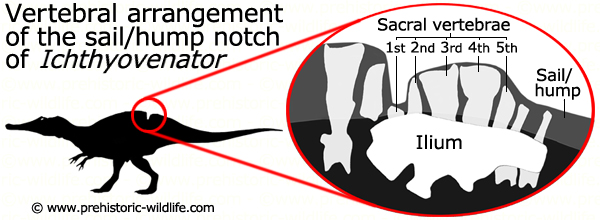
After
Siamosaurus,
Ichthyovenator is the second genus of spinosaurid
dinosaur to be named from Asia. However Siamosaurus
is only named
after teeth which is why it is often sometimes treated as a dubious
genus of dinosaur since further skeletal remains are going to be very
difficult to attribute to it. The few current remains of
Ichthyovenator do actually indicate that it belongs
in the
Baryonychinae, a sub group of the Spinosauridae. This means that
Ichthyovenator is currently considered to be related
to Baryonyx
from
England and also Suchomimus
from North Africa, although there is
speculation that Suchomimus may actually be a more
grown up Baryonyx.
The
genus name means ‘fish hunter’, while the type species name
laosensis means ‘from Laos’. Together, the
full species name of
Ichthyovenator laosensis means ‘fish hunter from
Laos’. The name
‘fish hunter’ is a reference to the fact that all known spinosaurids
seem to have been specialists in hunting fish rather than other
dinosaurs. This is because the long jaws and teeth of spinosaurids
are more suited to catching prey like fish and would be only marginally
effective in killing a larger dinosaur. Additionally the snouts of
spinosaurids which have been preserved with them seem to be developed
to house pressure sensitive receptors that would have allowed them to
sense fish swimming in water. Although these parts of Ichthyovenator
are unknown at the time of its description, it’s reasonable to assume
that it would have had a very similar appearance and lifestyle to other
better known spinosaurids.
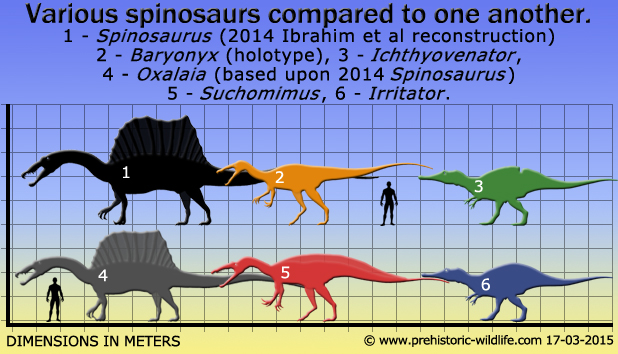
1 - Spinosaurus, 2 - Baryonyx, 3 - Ichthyovenator, 4 - Oxalaia, 5 - Suchomimus, 6 - Irritator.
Further reading
- The first definitive Asian spinosaurid (Dinosauria: Theropoda) from
the early cretaceous of Laos. - Naturwissenschaften 99:369-377. - R.
Allain, T. Xaisanavong, P. Richir & B. Khentavong - 2012.
- New material of the theropod Ichthyovenator from
Ban Kalum type
locality (Laos): Implications for the synonymy of Spinosaurus
and
Sigilmassasaurus and the phylogeny of Spinosauridae.
- Journal of
Vertebrate Paleontology Programs and Abstracts. - Ronan Allain - 2014.
----------------------------------------------------------------------------
Random favourites
 |
 |
 |
 |
